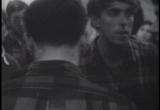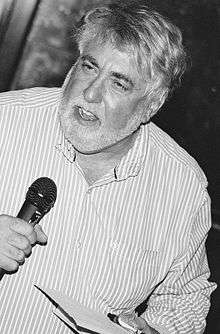Mark Rudd
| Mark Rudd | |
|---|---|
 Mark Rudd (right) with Tom Hayden Strand Bookstore, New York City, 2007 | |
| Born |
June 2, 1947 Irvington, New Jersey |
| Spouse(s) | Marla Painter |
Mark William Rudd (born June 2, 1947) is a political organizer, mathematics instructor, anti-war activist and counterculture icon most well known for his involvement with the Weather Underground.
Rudd became a member of the Columbia University chapter of Students for a Democratic Society (SDS) in 1963. By 1968, he had emerged as a leader for Columbia's SDS chapter. During the 1968 Columbia University Protests, he served as spokesperson for dissident students protesting a variety of issues, most notably the Vietnam War. As the war escalated, Mark Rudd worked with other youth movement leaders to take SDS in a more militant direction. When the general membership of SDS refused to go in a more violent and pro-Communist direction, Rudd together with some other prominent SDS members formed a radical, violence-oriented organization, referring to themselves collectively as "Weatherman" after the lyrics from a famous Bob Dylan song.
Rudd went "underground" in 1970, hiding from law enforcement following the Greenwich Village townhouse explosion that killed three of his Weather Underground peers. He surrendered to authorities in 1977, serving a short jail sentence. After serving as a mathematics instructor at Central New Mexico Community College, he is now retired in Albuquerque, New Mexico, and has since expressed some regret for advocating and using violence.
Early life
Rudd was born in Irvington, New Jersey. His father, Jacob S. Rudd (1909–1995), was born Jacob Shmuel Rudnitsky in Stanislower, Poland; he was a former army officer who sold real estate in Maplewood, New Jersey. His mother, Bertha Bass (1912–2009), was born in Elizabeth, New Jersey, the year after her parents emigrated from Lithuania. Rudd had a brother, David R. Rudd (1939–2009), who became an attorney. His family was Jewish.[1] Rudd attended Columbia High School in his hometown of Maplewood, New Jersey, and later Columbia University in New York.[2]
Campus activism

Mark Rudd's website says that his commitment to “fighting U.S imperialism”[3] was inspired by the revolutionary movement in Cuba, which at that time was in its ninth year.[4]
In 1968, Rudd and Bernardine Dohrn and other leaders of SDS were invited to Cuba to meet with Cuban, Soviet, and North Vietnamese delegates. His experiences in Cuba strengthened Rudd’s anti-war and pro-Communist sentiments.[5] Rudd had described the life of Cuba as “extremely humanistic” and he idealized Ernesto "Che" Guevara, referring to him as the “Heroic Guerrilla.”[6]
Once he returned from Cuba, Rudd was elected President of the Columbia chapter of SDS. In 1968, during his junior year, Rudd was expelled from Columbia after a series of sit-ins and riots that disrupted campus life and attracted nationwide attention. These events culminated in the dramatic occupation of several campus buildings, including the Administration building, Low Memorial Library, and which ended only after violent clashes between students and the New York Police Department.
The Columbia protest was not the first student revolt on an American campus, but as it occurred at a relatively conservative Ivy League school located just up the street from the headquarters of the nation's news media, it received considerable press coverage and drew many supporters. The protests produced the slogan “Create Two, Three, Many Columbias!” The Doonesbury character Mark Slackmeyer was inspired by Rudd.[7]
Revolutionary Youth Movement and Weather Underground
In 1969, as SDS membership grew rapidly, members' views concerning both goals and methods began to diverge widely. Rudd felt that SDS was not doing enough to protest the war in Vietnam. He was a leader of the Revolutionary Youth Movement (RYM), a faction of SDS, which advocated a more militant course of action while other factions within SDS were becoming concerned about Rudd's increasingly vocal calls for violent confrontation and hardline Communist sentiments. The 1969 SDS convention effectively splintered and ended the organization. Rudd and other former RYM members ultimately formed Weatherman, a self-proclaimed "organization of communist women and men." The new organization was intent on overthrowing the government through violent actions. Spreading communism was a priority for the members of Weather, as when Rudd told other members of SDS, “ Don’t be timid about telling people we’re Communist. Don’t deny it, be proud of it.”[8]
Years underground
Rudd and other members of Weatherman participated in an SDS National Action on October 8–11, 1969, an event which became known as the Days of Rage.[9] Charges filed against demonstrators following this action threatened the movement and its supporters. Rudd, along with other prominent members of Weather, went underground in March 1970 following the Greenwich Village townhouse explosion, an incident in which three members of the organization died when an explosive device, intended for a servicemen's ball, detonated prematurely. The dead were Terry Robbins, Diana Oughton, and Ted Gold, who was Rudd’s friend and partner in RYM and the Columbia sit-ins. Weatherman had already come to the attention of the FBI, but this explosion caused the members of Weatherman to take further precautions and to engage in more clandestine operations and according to some Weatherman members like Bill Ayers, build an underground revolutionary movement. After the townhouse explosion, the government actively sought to apprehend Mark Rudd and twelve other members of the Weather Underground Organization (WUO).[10] For seven years Rudd lived underground, although he was disengaged from the WUO for most of that time.
Reappearance
On October 13, 1977, Rudd turned himself in to authorities, tired of life as a fugitive. He had been living and working under an assumed name just a few miles from the Columbia campus in Brooklyn and was increasingly frustrated over his lifestyle which included his inability to see his family as well as working in manual labor jobs beneath his education. Due to FBI abuses against Vietnam protestors and others during the COINTELPRO program, Rudd could not be convicted of many of the crimes alleged in the original government complaint against him that led to his fugitive status. He received a small fine and ultimately spent less than one year in jail for all his crimes. His first public appearance was on campus, where he spoke to a crowd of hundreds of admiring students. He was not the firebrand the crowd expected, but he did participate in a march around the campus after the speech.[11]
Later developments

In the summer of 1978, Mark and his then-girlfriend, Sue LeGrand,[12] moved to Albuquerque, New Mexico. During his time there he became an instructor of mathematics at Central New Mexico Community College (then known as the Albuquerque Technical Vocational Institute, or TVI). At the time he was hired and during his early employment at the college, Rudd's years as a student radical and Federal fugitive were almost unknown to his students and other faculty members who seldom asked if he was “that” Mark Rudd. Most of these individuals were of a different generation and the name “Mark Rudd” had ceased to be a household word. Rudd regarded this lack of critical attention with some disdain.[13]
In 1990, he published a memoir called Truth and Consequences: The Education of Mark Rudd, which detailed his life with SDS, the Columbia University riots, and his time as a fugitive.[14]
Rudd was interviewed for the 2002 documentary, The Weather Underground, in which he stated that although the group's motivations, to end the Vietnam War and to oppose US imperialism, were justified, the violent actions performed in pursuit of those beliefs were questionable. He was the only former Weather member featured in the film that regretted his involvement in the group.
Today Rudd lives in Albuquerque, New Mexico, with his wife, Marla (Painter).[15] Rudd maintains a website called MarkRudd.com where he frequently posts essays and other writings, including his opinions on contemporary issues, and a personal appearance schedule.[16] He travels around the country in support of the newly reborn Students for a Democratic Society. Rudd, along with Brian Kelly of Pace SDS, have helped establish ties between the new SDS and the Kent State University movement. He recently published another book on his time with SDS and The Weathermen called “Underground: My Life with the SDS and the Weathermen,” which was published by Harper Collins in 2009 and is more a personal memoir on his life and times rather than a political statement as was his first book.
Documentary filmmaker Sam Green made a 2008 short entitled Clear Glasses, which focuses on a pair of glasses Rudd sent him.
In 2008, Rudd spoke about the Vietnam War era activities of SDS and his involvement in them for the award-winning documentary film Superpower by Barbara-Anne Steegmuller.
Works
- Mark Rudd, Truth and Consequences: The Education of Mark Rudd, Grove Press, 1990, ISBN 978-0-8021-1269-9
- Mark Rudd, Underground: My Life with SDS and the Weathermen, William Morrow, 2009, ISBN 978-0-06-147275-6
Notes
- ↑ http://www.markrudd.com/?about-mark-rudd/why-were-there-so-many-jews-in-sds-or-the-ordeal-of-civility.html
- ↑ U.S. Congress, pg. 95
- ↑ U.S. Congress, Pg. 96
- ↑ Markrudd.com, paragraph 11
- ↑ U.S. Congress, Pg. 96
- ↑ Markrudd.com, paragraph 13
- ↑ Rosen, James (April 12, 2009). "Book Review: 'Underground' by Mark Rudd". The Washington Post. Retrieved September 8, 2013.
- ↑ U.S. Congress, Pg. 101
- ↑ U.S. Congress, Pg. 101
- ↑ U.S. Congress, Pg. 102
- ↑ Markrudd.com, paragraph 35
- ↑ Markrudd.com, paragraph 36
- ↑ Rudd, Mark, Underground:My Life with the SDS and the Weathermen, 2009, p. 234.
- ↑ "Tom Hayden on Mark Rudd". Truthdig. Retrieved September 8, 2013.
- ↑ "The Kids Are All Right". markrudd.com. Retrieved September 8, 2013.
- ↑ Rudd, www.markrudd.com. Official website of Mark Rudd
References
- Perkins,Robin, "The Days of Rage in Perspective", Commentary, May 2001, p. 23-24.
- Jacobs, Ron, "The Way the Wind Blew: A History of the Weather Underground. Verso Publishing, 1997, p.233.
- Willis, Margaret, Revolutionalry Violence in America, Green Mountain Press, 1993, p.43-44.
- Rudd, Mark, Truth and Consequences: The Education of Mark Rudd, Grove Press, 1990.
- Unidentified author, “Who is Mark Rudd”. Markrudd.com, http://www.markrudd.com/
- Ninety Fourth Congress (1975) The Weather Underground: Report of the Subcommittee to investigate the administration of the internal security act and other internal security laws of the committee on the judiciary United States Senate. (Stock No. 052-070-02727-4) Washington, DC: U.S. Government Printing Office, Pgs 95-102.
- Time; September 26, 1977; "Aging Radical Comes Home"
- Rudd, Mark, Columbia. New York: SDS, 1969.
- "Why Were There So Many Jews in SDS? (or, the Ordeal of Civility)" by Mark Rudd
External links
| Wikimedia Commons has media related to Mark Rudd. |
- Mark Rudd's website
- Essay by Mark Rudd
- Mark Rudd Emerges from the Underground by Stephanie Lee, New York Press, March 24, 2009
- Former Radical Talks Choices and Mistakes by Annette John-Hall, Philadelphia Inquirer, May 11, 2009
- Appearances on C-SPAN
- Documentary film Superpower by Barbara-Anne Steegmuller, 2008